Maker A Fusion Reactor for the Rest of Us

Story and Photography by Charles Platt
“Watch out for any dog poop,” Ed Storms warns me as I step behind his scanning tunneling electron microscope (STM). Imported from Czechoslovakia, this sleek, state-of-the-art laboratory hardware dominates a recreation room that used to contain a ping-pong table. I don’t see any dog poop, but I have to pick my way around some furniture and across rubber exercise mats that Ed’s wife, Carol, placed beneath the equipment to prevent it from damaging the parquet floor.

In Storms’ low-energy nuclear basement garage, aging Macs do the grunt work of data acquisition, monitoring excess heat from fusion cells. In the background is a chemical work bench (left) and a vacuum deposition setup (far distance, right). Cells are assembled in the alcove at the rear.
Storms has a laconic sense of humor, but his relaxed style is deceptive. During more than a decade of supposed retirement, he has worked from his home with relentless ambition and infinite patience to understand and control an obscure phenomenon known as low-energy nuclear reactions (LENR). His latest acquisition, the electron microscope, is on loan from a small Chicago company of speculative investors who hope that Storms may make a crucial breakthrough in his one-man research initiative.
The stakes are immense. If LENRs exist and can be harnessed, they could eliminate our dependence on carbon-based fuels. Oil would become obsolete for most applications, and electric power lines would largely disappear as cars, homes, and airplanes would acquire their own individual nuclear power cells, capable of generating electricity for decades while costing virtually nothing to maintain. Moreover, LENRs would not be hazardous, quite unlike the dramatically dangerous fission and hot-fusion reactions that occur in bombs and nuclear power plants. Since they don’t emit chemical pollutants such as carbon dioxide, they could even alleviate global warming.
Hard to believe? Certainly, this kind of lyrical speculation seems uncomfortably reminiscent of “futuristic” visions from 1950s Popular Mechanics magazine covers, or classified ads offering mysterious additives that guarantee 100 miles from a gallon of gas. Since LENRs have been notoriously difficult to replicate on a reliable basis, many skeptics dismiss the entire field as “pathological science.”
Still, Ed Storms does not remotely fit the profile of a crackpot inventor. He spent most of his working life in Los Alamos National Laboratory, one of the most prestigious research environments in the world. Arriving with a degree in radiochemistry, his first task was to design and build a mass spectrometer — a device used to measure the presence of elements in vapor with extreme precision. He became involved in the SP100 program, an effort to build a power reactor for use in space, and he played a significant role in the Rover program, which developed a nuclear-powered rocket motor. This project reached the point where it was tested in Nevada. “We had a reactor with liquid hydrogen flowing in at one end and hydrogen gas coming out at the other end, around 2,500 degrees Kelvin,” Storms recalls. “The specific impulse and the thrust were just enormous. It could have taken 100 tons to the Moon without any problem. But Nixon killed the program when he needed the money to bomb Vietnam.”
The final and fateful phase of Storms’ tenure at Los Alamos began when Stanley Pons and Martin Fleischmann announced their discovery of “cold fusion” in 1989. The laboratory sponsored a major effort to replicate the effect. Of about 100 scientists who were involved, Storms was one of only three who succeeded. During a year-long series of 250 separate experiments, he measured excess heat on numerous occasions and detected tritium, a radioactive byproduct, 13 times, causing him to become convinced beyond any doubt that although the phenomenon was elusive, it was real.
“There’s a lot of room for the solitary experimenter.”
Other researchers lacked his persistence or were simply unlucky in their selection of metal electrodes, which turned out to be a crucial factor. Pons and Fleischmann were widely discredited, and Los Alamos almost forgot about cold fusion, along with most other conventional research institutions.
In 1991, Storms took early retirement. He retreated into an unspoiled, mountainous area of New Mexico, worked for two years with his wife to build a beautiful home among the pines and junipers, and then resumed his research on his own. Today, he is a central figure in a loose-knit international network of LENR researchers who work mostly outside of mainstream science and publish their results on a website (lenr-canr.org) for which Storms is the science editor. Piece by piece, they have accumulated a formidable body of evidence suggesting that nuclear fusion can and does occur at moderate temperatures, and can be demonstrated using equipment that is small enough, cheap enough, and safe enough to assemble on a kitchen table.
Storms picks up a wafer of palladium less than an inch long and places it in the chamber of his electron microscope. As a pump evacuates air from the chamber, a picture of the palladium appears on a video monitor. It looks like a lunar landscape, pitted and scarred.
“We know now that the nuclear reactions occur in micro domains,” he says, pointing to little blips in the image. “The amount of heat that we measure has to do with how many of those micro domains you create on the surface. The energy density is one million watts per cubic centimeter. Most of the sample is completely dead, but if you concentrate on the part that you know to be alive, a couple of microns below the surface, you’re up to 100,000 watts per cubic centimeter.”
He speaks in his habitually dry, academic style, but allows himself a wry smile. “This is a higher energy density than anything outside of nuclear weapons.” If he’s right, the only thing that makes LENRs safe to play with is that they occur on a microscopic scale, without creating any neutron radiation to trigger a chain reaction.
He shuts down the $175,000 electron microscope and we walk outside, across a decked area where hummingbirds drink from feeders overlooking a spectacular view of Santa Fe. In the far distance, beyond the town, Storms points to a thin white line which he identifies as tents that have been erected to cover a temporary stash of nuclear waste on a hillside near Los Alamos. While activists and politicians squabble over disposal plans, the “temporary” stash keeps getting bigger. Since LENRs create virtually no radioactive byproducts, Storms sees them not only solving the energy problem but the nuclear waste disposal problem, too.
We enter the other half of his house and walk down a red steel spiral staircase into a garage recessed into the hillside. Carpentry tools such as a radial-arm saw and a band saw remain here since he used this space for his home construction work, but most of the garage has been remade as a laboratory. A chemical workbench stands against one of the cinderblock walls, while an impressive array of vacuum equipment is mounted on an improvised bench opposite. Computers are hooked up to calorimeters, doing data acquisition.
Storms shows me a hand-fabricated electrolytic cell, which would look familiar to any high school student who has seen oxygen and hydrogen liberated by an electric current passing between two electrodes immersed in water. Martin Fleischmann’s idea was to substitute an electrode made from the precious metal palladium, which he immersed in deuterium oxide, commonly known as “heavy water.” Although it sounds exotic, heavy water is all around us as a trace isotope in everyday water. It yields deuterium,
AN ELECTRON MICROSCOPE AT HOME:
Edmund Storms, a former Los Alamos scientist, is spearheading the effort to develop a reliable way to enable cold fusion reactions.
1. Wafers of palladium, used as cathodes in Storms’ experiments, ready for analysis.
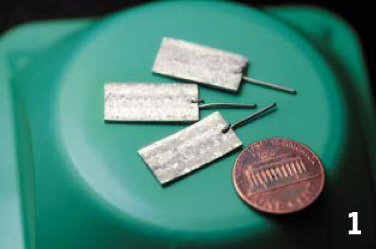
2. A palladium wafer is placed in the vacuum chamber of Ed Storms’ scanning tunneling electron microscope.

3. The microscope resolves an image of micro-domains on the palladium surface.

4. Storms sits with his STM where the ping-pong table used to be in his mountain retreat.
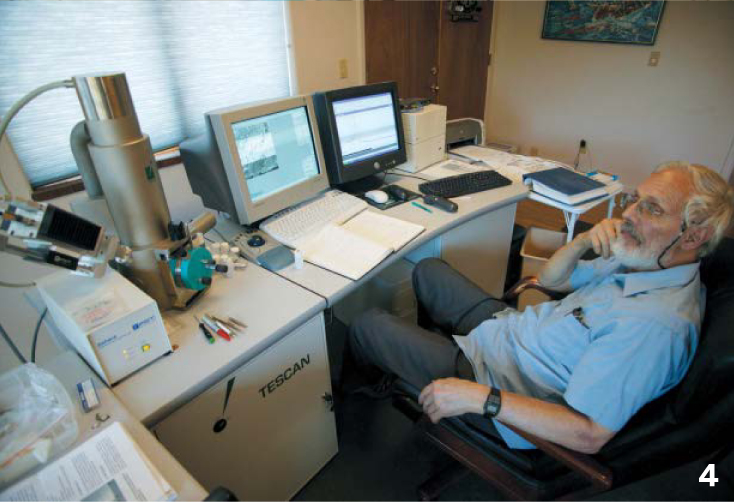
At 74, Storms shows no signs of slowing down — because he feels he has no choice: “Once you realize that this is real, you can’t go back, because your integrity and your conscience won’t allow you to go back.”
a fancy name for hydrogen that has one extra neutron in each of its atoms. The deuterium penetrates the lattice structure of the palladium, where Fleischmann theorized that nuclear fusion could occur after the deuterium has reached sufficient density. The fusion would liberate heat, which could be harnessed to create electricity.
According to conventional nuclear physics, this was impossible. Atomic nuclei repel each other so strongly, you should need huge amounts of energy to overcome that repulsion and make them fuse. LENR advocates responded by suggesting that unique conditions in a Pons-Fleischmann cell could change the rules regarding nuclear fission; but hot-fusion proponents insisted that positive results were “experimental errors,” even after one observer counted 92 separate groups who had validated the phenomenon.
The elusiveness of the phenomenon was blamed initially on impurities in palladium. “People analyzed the surface of the palladium,” Storms recalls, “and found platinum from the anode, silicon from the glass, boron from the Pyrex, lithium, and other elements — zinc, copper, and silver.” But subsequent studies indicated that impurities were actually necessary. “If the palladium is super pure, it doesn’t work,” Storms says. “We now believe that when the impurities reach a certain mix, they enable the phenomenon. I’ve seen this myself. On the occasions when I hit it right the first time, it turns on instantly. It takes no time at all.”
He claims the “micro domains” that foster LENR are most common where a thin film of one metal is deposited on another, and he uses an expensive vacuum deposition system to enable this. “I vaporize a palladium wire by passing a high current and low voltage through it,” he explains. “If you get it hot enough, it will vaporize without melting, and in a vacuum, you can deposit the vapor on other metals. Other people have done this with electrodeposition, but vapor deposition is cleaner. You can adjust the plating conditions to produce various geometrical characteristics, all kinds of morphologies, widely varying in size. My effort is to sort through that and find what it is about an active material that makes it unique.”
Since Storms is an experimentalist, not a theorist, he isn’t trying to explain why the phenomenon occurs. He is simply changing variables one at a time in the hope of hitting a combination that will make it occur more reliably.
This is the same kind of trial-and-error approach that Edison used when struggling to develop a working filament for a light bulb. It’s comparable, also, to the efforts of scientists who developed high-temperature superconductors — ceramic compounds that ought to behave as insulators yet somehow conduct electricity with zero resistance. Even now, no one knows exactly why these materials behave the way they do. In fact, according to orthodox theory, they shouldn’t work at all.
The problem with LENRs is that they are not only difficult to replicate but difficult to detect. Japanese researcher Tadahiko Mizuno claimed he once had a cell that generated 100 watts of heat throughout a period of several days, but such reports are rare, and a more typical result would be 50 milliwatts. Since you must put some electric power into a cell before it generates output, you have to be able to measure the difference between input and output power accurately while eliminating environmental factors and other sources of error, such as ordinary chemical reactions that produce heat of their own.
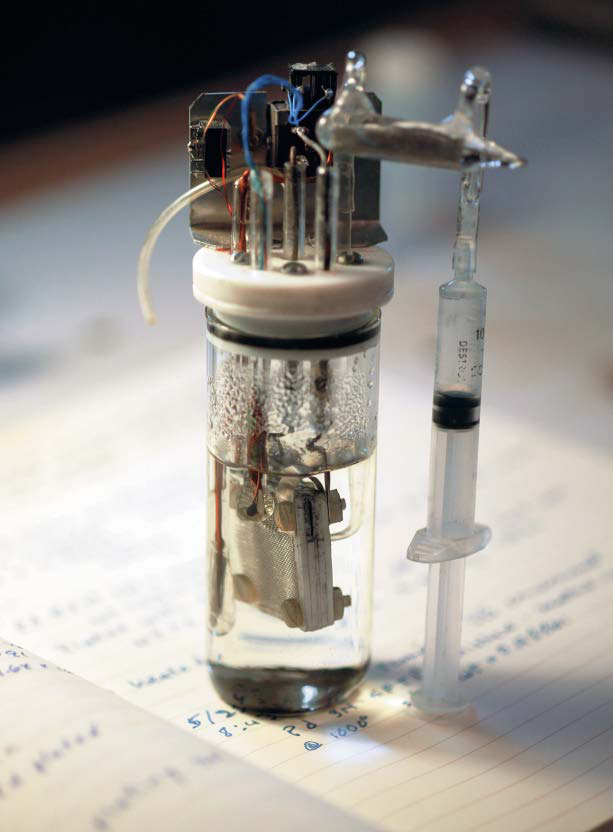
TEST CELL: Inside this typical electrolytic cell, the metal-mesh screen is an anode made from palladium. A glass-covered heater applies a known amount of energy, while a glass-covered thermistor measures temperature.
The first step in this direction is to place your LENR cell inside an insulated container known as a calorimeter. This protects the cell from outside temperature fluctuations while enabling accurate measurement of internally generated heat. “Anybody can build a calorimeter,” Storms says with a shrug. “A man named John Dash, at Portland State, actually teachers high school students how to do it, for cold-fusion experiments.”
On the LENR website, Storms has provided his own step-by-step guide for calorimeter construction — which seems appropriate, since he has been fabricating his own scientific equipment on and off throughout his life. When he was still a high school student, he constructed a Geiger counter, not only soldering electronic components onto circuit boards but learning to do glass blowing so that he could make his own detector tube. Even that wasn’t the end of the story: to create a good enough vacuum inside the tube, he had to build his own mercury diffusion pump.
The same spirit still motivates him now as he machines his own metal parts and does his own computer programming. He insists that others can make their own contributions to the field if they are willing to make this kind of effort. “There’s a lot of room for the solitary experimenter. I can name half a dozen people in the United States right now doing what I’m doing and having mixed success, and I get email from students who see that this work is real and valuable, and they want to get in on the ground floor.”
He feels that individuals will continue to play an important role in LENR research so long as the phenomenon remains elusive and poorly understood. “Anything truly creative in science is usually done on a small scale by a people outside of the mainstream of academia or the government. Entrepreneurs, little companies. And then, if it works, it grows. It becomes Microsoft.”
Storms isn’t trying to explain why cold fusion occurs. He is simply changing variables one at a time in the hope of hitting a combination that will make it occur more reliably.
Indeed, the history of science is peppered with instances where chance events enabled individuals to make radical discoveries. In the 1700s, Galvani learned accidentally that muscles can be triggered by electricity. French physicist Henri Becquerel discovered the radioactivity of uranium entirely by chance, in 1896. Penicillin, smokeless guncotton, organometallic compounds, and the industrial synthesis of polyethylene and Teflon all entailed an element of chance, often because equipment was poorly maintained or accidentally contaminated.
If Storms does manage to hit upon the ideal conditions to trigger LENRs, he believes the phenomenon will be harnessed for commercial purposes almost immediately. “Nanotechnology is coming along,” he points out, “and the computer industry knows how to put down any morphology on a microscopic scale.” As soon as the ideal configuration of microdomains is established, semiconductor labs should have no trouble mass-producing nuclear batteries.
Currently, however, the stigma associated with cold fusion continues to discourage well-funded research and development. A recent review by the Department of Energy refused to advocate the allocation of public money, and the academic community remains hostile. “In the United States, they simply are not willing to explore new ideas readily,” Storms comments. “That’s why a lot of the work now is being done in Italy, Russia, and Japan.”
Almost all peer-reviewed journals still refuse to publish LENR papers, while open communication is difficult even within the community. “People who are successful now are not broadcasting the results until they get their patents,” Storms says. “Whenever someone has information of any substance, they make you sign a nondisclosure agreement, and after that, you can’t talk about it.”
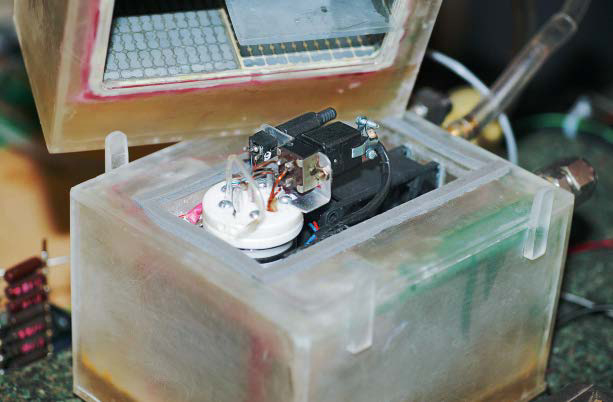
A Seebeck calorimeter opened to expose an electrolytic cell in which heat may be generated by low-energy nuclear reactions.
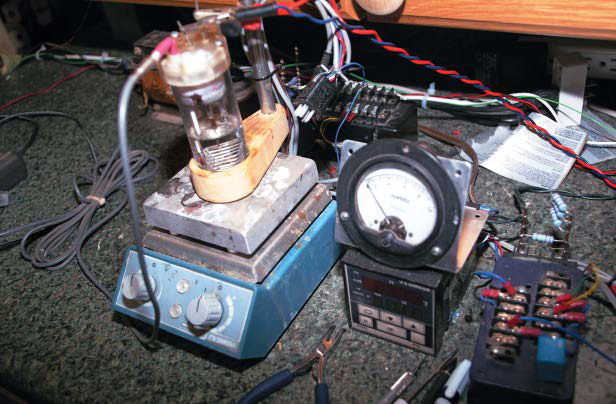
Inside this cell, metals can be plated onto the surface of palladium wafers.
Has he been in that position himself?
“Oh, sure. I’ve signed half a dozen NDAs.”
Still, he remains fundamentally optimistic, and at the age of 74 he shows no signs of slowing down — because he feels he has no choice. “Once you realize that this is real,” he says, “you can’t go back, because your integrity and your conscience won’t allow you to go back. You know, Carol wants me to work on the house, and I kid her, I don’t have time, because I’m too busy saving the world. That’s how big this is.”
He pauses, perhaps wondering if he sounds a little over-dramatic. “When you retire, you have to do something to keep yourself occupied,” he says, retreating to his more usual laconic style. “And since I don’t play golf,” he gestures at the cluttered garage workshop, “I might as well be here.”
Cold Fusion 101
Learn how to make your own calorimeter and/or LENR cell. Find PDF files about the following at: lenr-canr.org/acrobat/
StormsEcalorimetr
Washington Post on LENR:
Charles Platt has been a senior writer for Wired magazine and has written science fiction novels such as The Silicon Man.
WHAT IS COLD FUSION?
Nuclear fission splits atomic nuclei to produce energy, while nuclear fusion joins nuclei together to produce energy.
Nuclear power plants cause fission reactions by adding neutrons to plutonium or uranium atoms to make them unstable enough to split. When the atoms split, they release additional neutrons, which bombard additional radioactive atoms, causing them to split. Nuclear power reactors use control rods to absorb some of the neutrons to prevent a chain reaction that would lead to a meltdown.
Fusion is harder to achieve, at least by people. The sun and stars are giant fusion machines, but here on Earth, getting deuterium or tritium nuclei to collide with enough force to fuse them together requires very high temperatures. Researchers try to contain the reaction in powerful magnetic fields (solid containers would be vaporized) but progress in this field has been slow.
When Professor Martin Fleischmann of Southampton University and Professor Stanley Pons of the University of Utah announced the discovery of “cold fusion” in March 1989, the news tore through the scientific community like a nuclear explosion. Most scientists could not repeat Pons and Fleischmann’s results, and the consensus was that the scientists were careless and foolish at best and scam artists at worst.
But a small number of scientists said they were able to reapeat the results, and research has continued on a small scale. in 2004, the U.S. Department of Energy reviewed the current cold fusion research and concluded, “The experimental evidence for anomalies in metal deuterides, including excess heat and nuclear emissions, suggests the existence of new physical effects.” According to Storms, the Pons-Fleischmann experiment has been successfully repeated hundreds of times in the last 16 years.
Today’s experimental cold fusion setups are more elaborate than the original Pons-Fleischmann cell, but the general idea is the same. The theory is that the deuterium dissolves in the palladium in such a way that the deuterium nuclei (which normally repel one another with great force) come close enough to fuse.
— Mark Frauenfelder
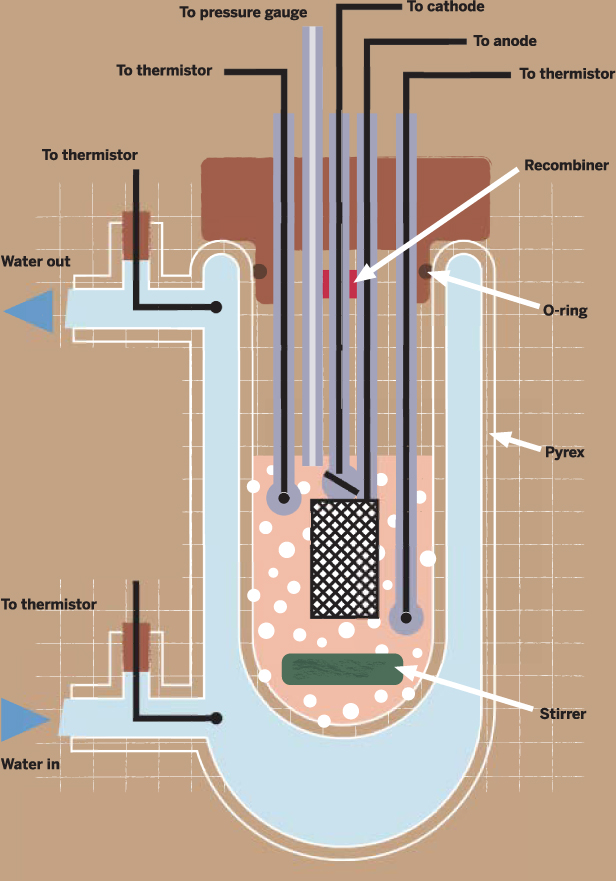
Anatomy of a Fuel Cell: Cross-section of a cold-fusion cell shows electrodes immersed in deuterium oxide (heavy water) in the hope of inducing nuclear fusion in a palladium electrode. Excess heat is measured by monitoring the temperature of water flowing around the cell. Materials to build a cell are relatively cheap, but construction is nontrivial, and meaningful experimental results will require extremely careful technique.
Illustration by Mark Frauenfelder
